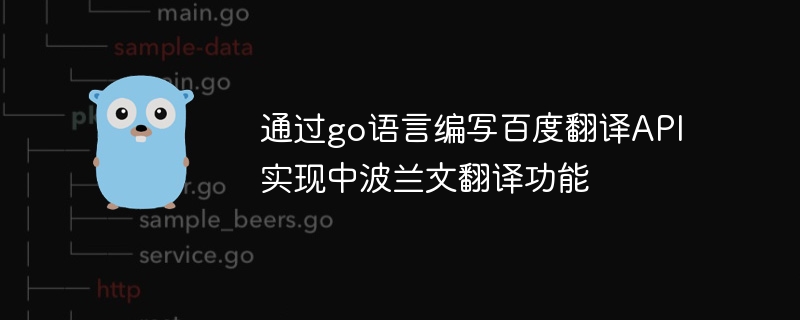

Title: Use Go language to write Baidu Translation API to implement Chinese-Polish translation function
Abstract: This article introduces how to use Go language to write a simple program through Baidu Translation API to realize the function of translating Chinese to Polish. Through the sample code in this article, readers can learn how to call APIs, process JSON data, and perform string internationalization processing.
Introduction: With the acceleration of globalization, the demand for language translation is increasing day by day. Baidu provides a set of powerful translation APIs that developers can use to implement translation functions in various languages. This article will introduce how to use Go language to call Baidu Translation API to realize the function of translating Chinese into Polish.
1. Preparation work
Before use, we need to do some preparation work. First, we need to register an account on the Baidu Developer Platform, then create an application and obtain the API Key and Secret Key. Then, we need to install the Go language development environment.
2. Introducing dependent libraries
In the Go language, we can use third-party libraries to simplify our development process. In this article, we use the http and url libraries in the golang.org/x/net package to perform HTTP requests and URL encoding and decoding operations. We can use the following command to download these dependent libraries:
go get golang.org/x/net/http go get golang.org/x/net/url
3. Implement the translation function
We can use the following code to implement the function of translating Chinese into Polish:
package main
import (
"crypto/md5"
"encoding/hex"
"fmt"
"net/http"
"net/url"
"strconv"
"time"
)
func main() {
apiKey := "your_api_key"
secretKey := "your_secret_key"
q := "你好"
from := "zh"
to := "pl"
salt := strconv.FormatInt(time.Now().Unix(), 10)
sign := fmt.Sprintf("%x", md5.Sum([]byte(apiKey+q+salt+secretKey)))
urlParams := url.Values{}
urlParams.Set("q", q)
urlParams.Set("from", from)
urlParams.Set("to", to)
urlParams.Set("appid", apiKey)
urlParams.Set("salt", salt)
urlParams.Set("sign", sign)
apiUrl := "http://api.fanyi.baidu.com/api/trans/vip/translate"
resp, err := http.PostForm(apiUrl, urlParams)
if err != nil {
fmt.Println("请求失败:", err)
return
}
defer resp.Body.Close()
if resp.StatusCode != http.StatusOK {
fmt.Println("请求失败,错误码:", resp.StatusCode)
return
}
var result struct {
From string `json:"from"`
To string `json:"to"`
TransResult []struct {
Src string `json:"src"`
Dst string `json:"dst"`
} `json:"trans_result"`
}
if err := json.NewDecoder(resp.Body).Decode(&result); err != nil {
fmt.Println("解析响应失败:", err)
return
}
for _, res := range result.TransResult {
fmt.Println(res.Src, "=>", res.Dst)
}
}In the above code, we first define some necessary parameters, such as API Key, Secret Key, text to be translated, translation source language (Chinese) and target language (Polish). Subsequently, we generate a random number salt and signature sign, which are used to construct the request parameters. Then, we sent a POST request to the Baidu Translation API using the http.PostForm method and got a response.
4. Run the program
After finishing writing the code, we can run our program through the following command:
go run main.go
If everything goes well, we should be able to control Taiwan to see the translation results.
Conclusion: Through the sample code in this article, readers can learn how to use Go language to call Baidu Translation API to realize the function of translating Chinese into Polish. By learning operations such as API calls, JSON data processing, and string internationalization processing, readers can further develop more powerful and practical translation functions.
The above is the detailed content of Write Baidu Translation API in Go language to implement Chinese-Polish translation function. For more information, please follow other related articles on the PHP Chinese website!
 Usage of Type keyword in Go
Usage of Type keyword in Go
 How to implement linked list in go
How to implement linked list in go
 What are the Go language programming software?
What are the Go language programming software?
 How to learn go language from 0 basics
How to learn go language from 0 basics
 What are the methods to implement operator overloading in Go language?
What are the methods to implement operator overloading in Go language?
 What are the operators in Go language?
What are the operators in Go language?
 How to solve invalid syntax in Python
How to solve invalid syntax in Python
 How to set cad point style
How to set cad point style




